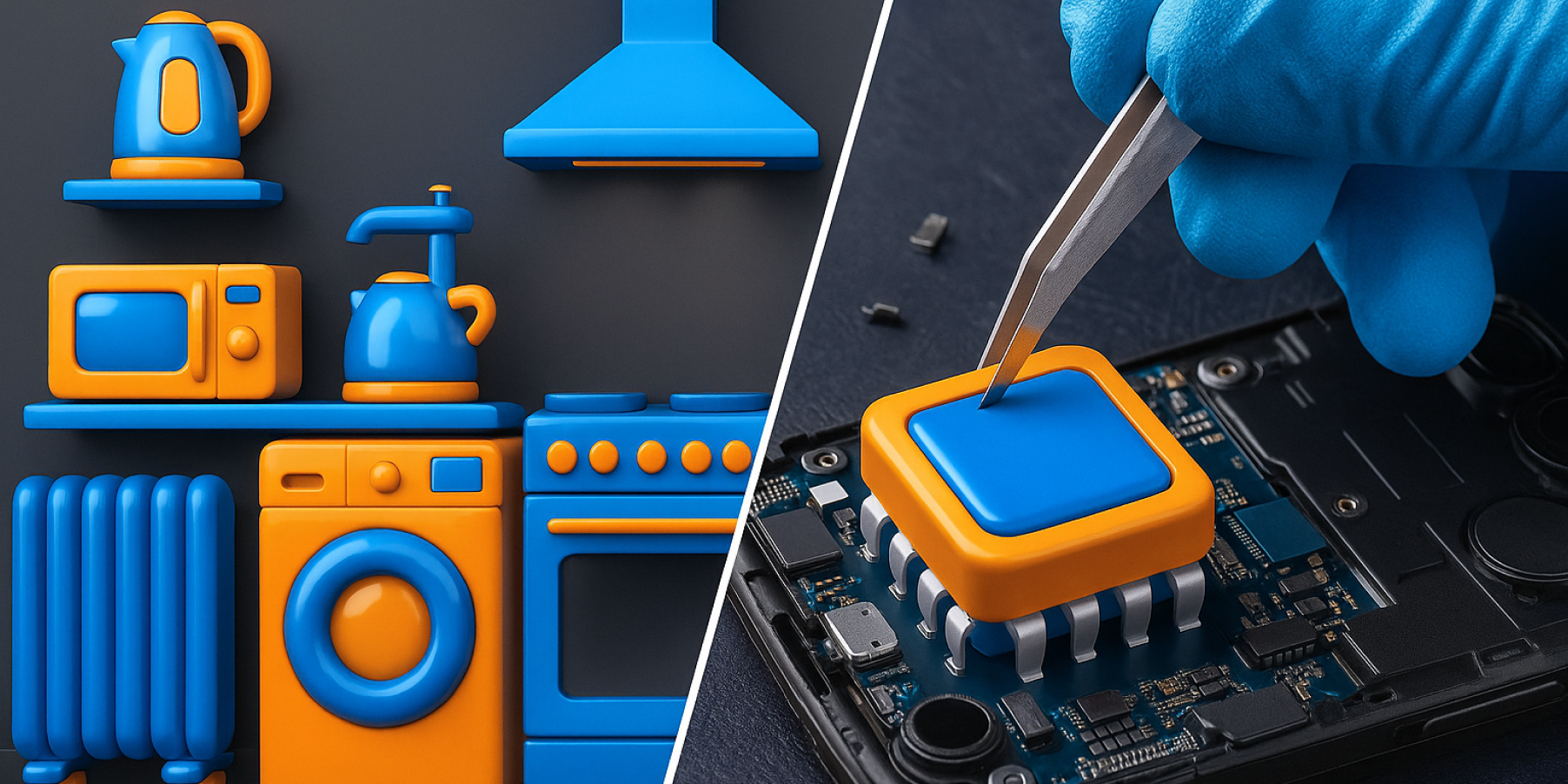Right to Repair in the EU: What It Means for Electronics Manufacturers and Retailers
September 14, 2025

The European Union has adopted a recent law granting consumers the right to fix household items, even after the warranty period ends. Let’s look at what this means for electronics manufacturers, as well as the challenges and opportunities ahead.
What the new directive changes
The European Parliament approved the Directive on the Repair of Goods (2024/1799), which comes into force on July 31, 2026. Its goal is to make appliance maintenance easier, more affordable, and more attractive than buying a replacement. The regulation focuses on:
- extending product lifecycles and simplifying restoration,
- ensuring a reasonable price and timeframe for fixing,
- reducing e-waste and promoting the circular economy.
This element is part of the European Green Deal. As the electronics industry grows, so does its environmental impact. According to Eurostat, in 2022 alone the EU generated 14.4 million tons of electronic units, of which only about 5 million tons were recycled. The rest either remain in circulation or eventually turn into electronic waste.

Data from the Commission on Waste Electrical and Electronic Equipment (WEEE) shows that longer use and proper recycling of devices help cut waste and reduce CO₂ emissions. In other words, prioritizing upkeep not only saves money for users but also lowers the EU’s environmental footprint.
New obligation to repair for manufacturers
The Directive reshapes how brands handle device design, production, and after-sales support. Below are the main duties that ensure users have access to affordable and reliable servicing.
- Affordable fixing. Suppliers must offer maintenance at prices similar to or below those of a current device, within a reasonable timeframe for repair defined by member states. The regulation includes the software/hardware lock-ins ban, which prevents artificial limitations on restoration options.
- Transparency of prices and timeframes.Producers and help teams must publish indicative maintenance prices, timelines, and repair quality standards on their websites, so customers can access this information without additional requests.
- Extended warranty after upkeep. If a consumer opts for fixing instead of replacement, the coverage is prolonged by one year, even if the original warranty was still active.
In addition, EU member states are introducing initiatives to encourage maintenance, such as repair vouchers, training programs, and funding for refurbishment projects. In 2027, the European Repair Information Form and a dedicated portal are set to launch, allowing consumers to find support centers, sellers of refurbished devices, and community workshops. roducers and authorized technical support teams will be required to register, keep their information up to date, and remain accessible to users.
The law also promotes independent repairers competition, giving small workshops more opportunities to compete in the after-sales market.
For producers, the directive reshapes everything from device design to assistance. It raises costs, demands fast adaptation, and disrupts established operations.
How the law will impact the electronics industry and access to spare parts
Customer support is no longer an optional add-on but an integral component of the business model. This shift influences core areas of operations for organizations.
Items must become technically maintainable
To comply with the updated requirements, suppliers must redesign appliances and rethink materials. Key changes include:
- phasing out glue and sealed components,
- switching to screws and standardized modules,
- using elements that can be easily replaced, restored, or sourced as second-hand or even 3D-printed spare parts.
These updates will raise development costs but make it easier to replace components and focus on prolonging the lifespan of products.
Growing demand for customer assistance
Companies are requiredto build efficient help systems by:
- keeping spare parts in stock for quick replacement,
- ensuring fast delivery of missing components,
- partnering with help centers,
- launching training programs for technicians and users,
- creating incentives to choose repair.
This transforms the manufacturer from a one-time seller into a long-term partner for clients.
Business models will shift in the after sales market
Instead of relying on quick device turnover, organizations will adopt alternative revenue strategies:
- assistance contracts and maintenance subscriptions,
- leasing and rental with long-term guarantees,
- upgrades for extending product longevity.
Such approaches generate recurring income and build brand trust.
Main challenges in the after sales sector
Adapting to the updated framework requires companies to revise processes across the value chain. The key challenges are:
- Extending devices lifecycle: investing in durable designs and materials to extend device lifespan.
- Spare components logistics: managing inventory, training staff, working with help centers, and offering online availability to manuals and parts.
- After-maintenance service: ensuring transparency in repair conditions, including clear pricing and timeframes, as well as access to repair information.
- Regulatory compliance: maintaining documentation, quality control, internal audits, and alignment with local laws to avoid penalties for non-compliance and sector restrictions.
Adjusting to these requirements will help companies reduce operational risks and maintain organizational stability.
Business opportunities under the directive on repair of goods

The rule opens alternative development paths for operations that adapt quickly. It creates favorable niches and helps strengthen leadership. The law encourages the development of resource ecosystems, innovative operational models, and stronger user connections.
Growth of support solutions and latest revenue streams
Operations can expand into technical support and upkeep by:
- setting up specialized help centers and mobile repair crews,
- selling self-service maintenance kits and offering user guidance,
- introducing subscriptions for regular check-ups.
This also benefits community workshops and manufacturers: through nearby platforms such as ServiCom, they can gain visibility, reach nearby clients, and increase sales.
Strengthening customer loyalty
Clear information about serviceability, fast technical support, and warranty extensions increase user confidence. Clients are willing to pay more for convenience and reliability, backed by consumer information on repair rights, which also unlocks profitable market segments.

According to the European Commission, 77% of EU citizens prefer fixing equipment instead of buying new. Investments in user-friendly assistance directly support repeat purchases and LTV growth.
Growing the resale ecosystem
Used devices become more attractive when backed by proper instruction and support. Companies can:
- sell refurbished products,
- run trade-in and upgrade programs,
- contribute to green transition and reducing waste.
A strong secondary market attracts new buyers and strengthens a brand’s image as responsible and environmentally conscious.
Innovation and differentiation
To remain competitive, companies can launch innovative offerings and support solutions with added value, such as:
- creating an online repair platform for spare parts and consultations,
- offering personalized upkeep packages for different customer segments,
- integrating modular upgrades and product warranty extension into leasing and subscription models.
These solutions help build unique client offerings and ensure a sustainable competitive edge.
Upcoming jobs and skills
According to the Institute for European Environmental Policy (IEEP), the recent legislationcould create up to 700,000 new jobs in the EU by 2030, particularly in the fixing sector and the social economy.
This opens further opportunities for SMEs and supports the development of local service ecosystems.
Recommendations for companies under the right to repair
To adapt to the updated rules and maintain industry position, businesses should:
- review their offerings portfolio and identify models that can be quickly adjusted to meet requirements,
- invest in assistance and logistics by organizing spare parts warehouses, training teams on new standards, and providing online access to manuals and components,
- communicate with customers and highlight fixing availability as a competitive advantage,
- develop innovativeenterprise approaches such as leasing, service subscriptions, and upgrades to support product lifecycle extension,
- monitor legislation and stay regulatory changes.
This approach allows companies not only to comply with the law but also to turn it into a growth driver.
Conclusion
The right to repair sets modernized rules for the entire electronics sector. Starting in 2026, companies face a clear choice: make products technically repairable and build customer-centric service, or risk losing competitiveness and access to the European industry.
Follow our blog to stay updated on the latest market trends.









